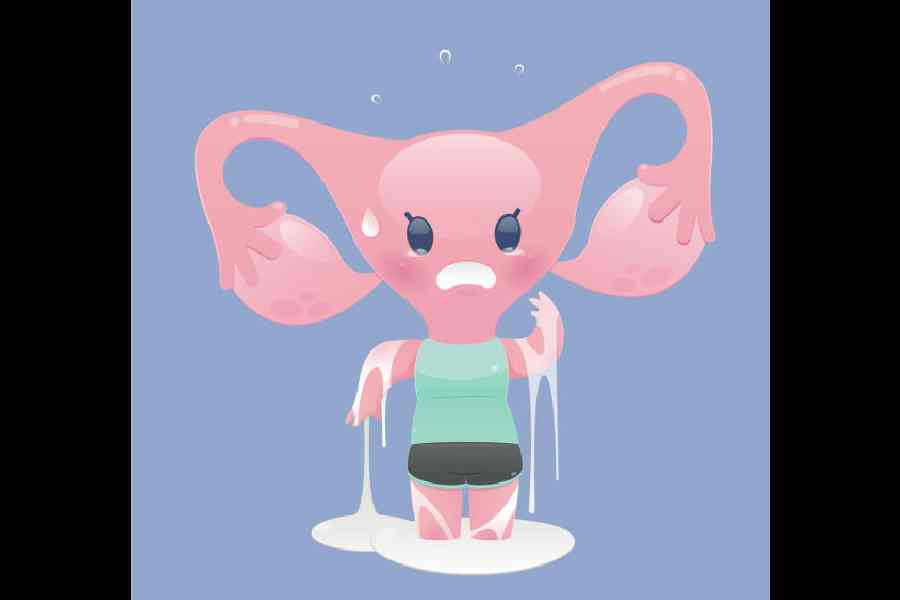Many women of various ages go to physicians and complain about vaginal discharge. Even though talking about it makes them uncomfortable, they want answers and treatment.
Newborn female babies sometimes have a white or even blood-stained vaginal discharge. This occurs because the mother’s hormones cross the placenta, affecting the baby’s uterus. After delivery, these hormone levels fall rapidly, and the discharge usually resolves spontaneously in 10 days without treatment.
Some amount of vaginal discharge is normal after puberty. Many people do not understand this and are worried. It occurs because of the action of the hormones estrogen and progesterone in the uterus and vagina.
In a normal menstrual cycle, bleeding occurs on days 1-5, and white discharge starts on day six and lasts till the next bleeding starts. This normal discharge is colourless or pearly white. It is odourless and is not accompanied by itching or abdominal pain.
Sometimes, the discharge may increase because the woman uses scented washes or douches and irritates the vagina with frequent cleaning. The underwear may be made of synthetic material that traps sweat and does not allow air in. Even the detergent with which underwear is washed should be mild and non-irritating. Underwear should not be rinsed out with antiseptics and should be changed daily.
Sometimes, while wearing salwars, pants or shorts, the woman dispenses with underwear. This should not be done as the stitching can injure the delicate vaginal epithelium, causing a discharge. Women who have hormonal imbalances because of PCOD or have taken hormonal tablets can also have an overgrowth of fungus. This causes an itchy white discharge.
Some harmless commensal bacteria and viruses live in the vagina. If there is a metabolic disease like diabetes, especially if it is uncontrolled, the normal friendly bacteria can be overrun by fungus. The commonest fungal infection is from the candida group of organisms. The discharge immediately becomes curdy, thick, white and causes intense uncontrolled itching.
When there is a urinary tract infection, the infected urine contains disease-causing bacteria, which kill the good bacteria in the vagina, and there is an overgrowth of fungus. Antibiotic usage, immune suppressants or cancer treatment can also cause this.
Foreign bodies may be present in the vagina. This may be tampons, cotton or cloth forgotten there during a period or even the threads of an intrauterine contraceptive device. Children may insert buttons or toys into the vagina. This can cause an infection.
A widespread infection is caused by the organism Trichomonas vaginalis. It causes a painless, frothy, green discharge. It is easily treated but can be transmitted between partners. So, both may need to be treated.
Antibiotics and other medications can alter normal vaginal flora. Overgrowth of normal vaginal bacteria can cause a discharge with a fishy odour. This can be easily treated and the balance restored.
If a person feels that they have a white discharge, they should consult a physician. An examination of the private parts, a smear of the discharge, a pap smear, and an ultrasound of the abdomen and pelvis can be done. Blood and urine tests should be done to rule out diabetes, urinary tract infections and sexually transmitted diseases (STDs).
Antibiotics and antifungal agents can cure infected white discharge. The whole course of medication should be completed. Local applications of ointments may be required for fungal infections. Sometimes, both partners need to be treated.
Taking a tablespoon of homemade curd on an empty stomach helps repopulate the vagina with good bacteria. Sitting in a basin of warm water to which a quarter teaspoon of salt and a tablespoon of soda bicarbonate is added acts as an adjuvant to treatment and can help reduce the smell and itching while specific treatment is taken.
The writer has a family practice at Vellore and is the author of Staying Healthy in Modern India. If you have any questions on health issues please write to yourhealthgm@yahoo.co.in










